The Ultimate Guide to Butterfly Knives: History, Safety & Flipping Tips
October 24th, 2025
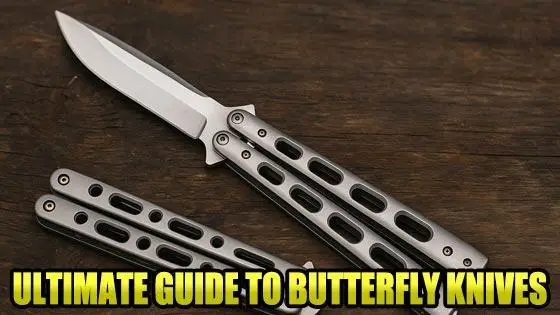
There is something addictive about a butterfly knife. The sound of the handles clicking together, the smooth spin of the blade as it flips open, and the sense of control when you finally land that first trick all hook you fast. Known as balisongs, these knives have been around for centuries and are loved just as much for their craftsmanship as for their flashy moves. Whether you want to learn how to flip one safely, keep it tuned up, or just understand where these knives came from, this guide will walk you through it all in plain English.
What Is a Butterfly Knife (Balisong)?
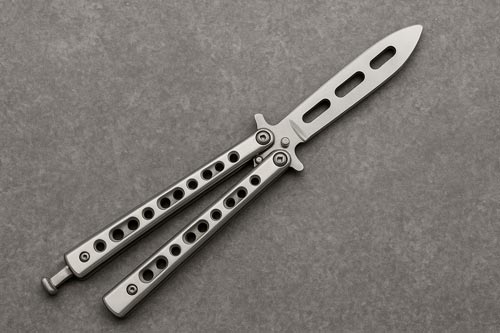
A butterfly knife, or balisong, is one of the most unique folding knives ever made. Instead of a single handle that folds over the blade like a normal pocket knife, a balisong has two handles that rotate around the tang. When it's closed, those handles meet together and completely cover the blade, keeping it safe and compact. With a quick flick of your wrist, the two handles swing apart, and the knife locks into an open position. That fast, fluid motion is what makes flipping so addictive for so many people.
Most butterfly knives use a latch at the bottom of the handles to keep them securely closed or locked open. You'll also hear about "safe handles" and "bite handles." The safe handle is the one that won't cut you when the knife is open, while the bite handle is the one connected to the sharp edge. When you start flipping, knowing which handle is which will save you from a lot of bandages. Many beginners start with a trainer balisong that has a dull blade so they can build muscle memory before moving up to a live edge.
The design of the balisong isn't just for looks or tricks. It actually makes the knife incredibly sturdy because the handles lock straight along the tang. There's no side-to-side flex like you might feel in some folding knives. That's one reason why balisongs have lasted for centuries. They started as everyday utility knives in the Philippines and evolved into a mix of art, sport, and self-expression. Today, they're just as likely to show up in a collector's display as they are in a flipper's hand at the park.
A Short History of the Balisong
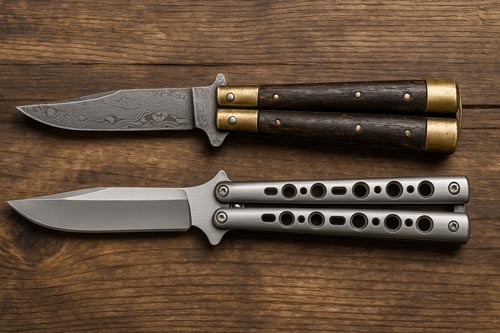
The butterfly knife didn't start as a flashy trick knife. Its roots go way back to the Philippines, where it was used as a simple utility tool and, at times, a weapon for self-defense. The word "balisong" actually comes from a Filipino term meaning "broken horn," named after early models that used carved animal horn for the handles. Farmers and craftsmen used them for everyday cutting jobs, and the design caught on because it was sturdy, compact, and easy to carry.
When American soldiers came across balisongs during World War II, they brought them back home, and that's when the knife's reputation really exploded. By the 1970s and 80s, butterfly knives were showing up in martial arts movies, street performances, and knife collections all over the world. That combination of speed, danger, and skill made them iconic almost overnight.
Modern balisongs come in two main styles: traditional and sandwich. Traditional versions use pins through the handles to hold everything together, while sandwich-style models are built in layers with screws and bushings. The sandwich style is easier to maintain and has become the standard for high-end balisongs today. Whether you love them for flipping, collecting, or just the history, every butterfly knife still carries a bit of that old Filipino craftsmanship in its design.
How to Flip a Butterfly Knife Safely
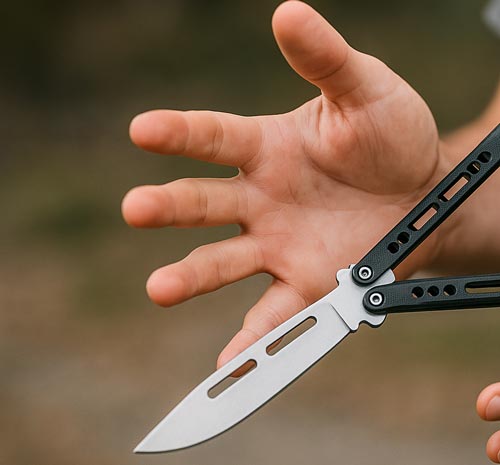
Flipping a butterfly knife looks impressive, but it is one of those skills where confidence can get you cut if you are not careful. The key is to start slow and focus on safety before you try anything fancy. The first rule every flipper learns is to always hold the safe handle, which is the handle that is not connected to the sharp edge of the blade. Holding the bite handle can end a practice session fast. Once you know which side is safe, you can start working on basic openings and closings with full control.
If you are just starting out, grab a trainer balisong. These look and feel like the real thing but have dull blades that will not slice your fingers. They are perfect for learning how the knife moves and how the handles swing. When you practice, stand over a soft surface like carpet or grass so drops will not damage your knife. Avoid hard floors until you are comfortable flipping without losing grip. It helps to flip over your bed at first, that way the worst thing that happens is your knife bounces instead of breaks.
Start with simple moves like the basic opening, closed-to-open rotation, and latch drop. These teach you the rhythm of flipping and how to control the knife's balance. The trick is to move slow and smooth, not fast and wild. Once your hands learn the flow, the speed will come naturally. Every flipper remembers that first time they got the handles moving perfectly, it feels almost like a dance move that finally clicks. Keep your focus on smoothness and safety, and you will build skill a lot faster than if you rush it.
Maintenance and Tuning: Keeping Your Balisong Smooth
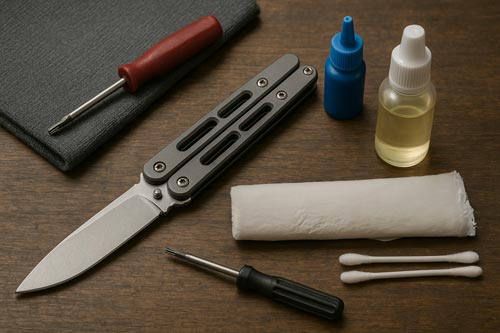
Flipping a butterfly knife feels best when the motion is clean and effortless, and that all comes down to good maintenance. Even the nicest balisong will start to feel rough if it gets dirty or loose. Dust, pocket lint, and tiny bits of metal shavings from normal wear can build up around the pivots. A quick cleaning every few weeks can make a huge difference in how your knife flips.
Start by removing the latch and handles if your knife design allows it, then wipe everything down with a soft cloth. Use a small brush or cotton swab to reach the tight spots near the tang and washers. A drop or two of quality knife oil on each pivot is usually all you need. Avoid over-oiling since that just attracts more debris. After cleaning, work the handles a few times to spread the lubricant evenly and check for any unwanted play or stiffness.
If your balisong starts to feel loose, it might be time for a quick tune-up. Grab a Torx screwdriver set and gently tighten the pivot screws a quarter turn at a time. Do not crank them down hard or you'll lose that smooth swing. Some flippers use a tiny bit of threadlocker on the screws to keep them from backing out. Just be sure to use the blue (removable) type instead of the red permanent stuff. Once everything feels right, your balisong should swing freely without wobbling, clicking, or sticking.
Taking care of your knife doesn't just make it perform better; it keeps it safer too. A well-tuned balisong moves predictably, which means you are less likely to get surprised by a sudden slip or jam mid-flip. Treat maintenance like part of your practice routine, and you'll keep your knife flipping like new for years.
How to Choose the Right Butterfly Knife
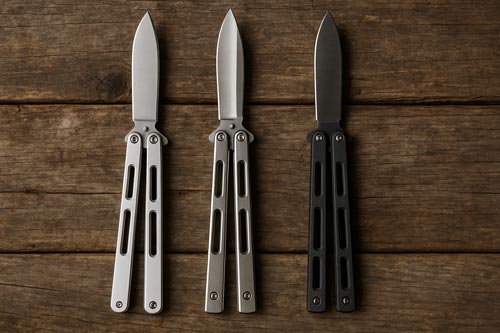
Picking your first butterfly knife can be a little intimidating because there are so many different styles, materials, and prices out there. The good news is that finding the right one mostly comes down to how you plan to use it. If your goal is to learn tricks and flips, you will want something balanced, durable, and easy to control. If you are buying one more for collection or display, you might focus on craftsmanship, design, or historical appeal.
For beginners, trainers are a great place to start. These have dull blades but still feel like a real balisong in weight and motion. A trainer lets you practice safely without turning your hands into a first-aid project. Once you get comfortable flipping, you can upgrade to a live blade made from stainless or high-carbon steel. The most important thing is to start slow and make sure the knife feels right in your hand. A well-balanced balisong should swing smoothly without too much handle play or resistance.
Handle material makes a big difference too. Aluminum handles are light and fast, which makes them great for quick tricks. Stainless steel handles are heavier and give you more control but can be tiring during long sessions. G10 or carbon fiber handles sit somewhere in between and add a little extra grip. If you want a knife that lasts, look for quality hardware like bushings or bearings in the pivots, since those parts keep everything moving smoothly.
Finally, think about the size. Most butterfly knives range from 8 to 10 inches when open. Smaller ones are easier to flip for beginners, while larger models feel more dramatic and stable. There is no "best" balisong for everyone; it really comes down to what fits your hand and your style. Once you find that perfect balance, flipping feels almost effortless, and that is when the real fun begins.
Butterfly Knife Laws and Safety Tips
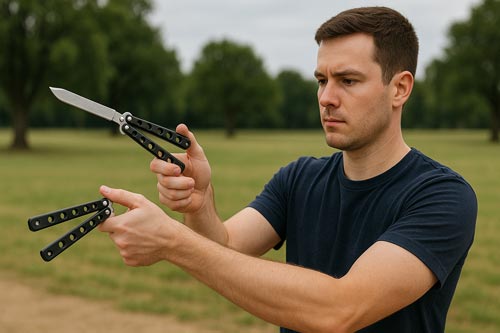
Before you start carrying or flipping a butterfly knife outside your home, it is really important to understand the laws where you live. Balisong laws change from state to state, and in some places, even from city to city. What is perfectly legal to own in one area might be restricted or even banned in another. Most states allow you to own a butterfly knife at home, but carrying one in public can be a completely different story. Always check your local regulations before you buy or travel with a balisong. A quick online search for your state's knife laws can save you a lot of trouble later.
When it comes to safety, common sense goes a long way. Never flip your knife near other people or pets, and always make sure you have plenty of space around you. A clear area without furniture or walls nearby helps you avoid accidental damage or injury. If you are learning new tricks, wear a long-sleeve shirt and flip over a soft surface until you are confident. Many flippers also keep a small first aid kit nearby just in case they catch a handle wrong or misjudge a spin. It happens to everyone eventually, even experienced flippers.
Another good habit is to always inspect your knife before flipping. Loose screws, a bent latch, or sticky pivots can make the knife unpredictable. A few seconds of checking for tightness or dirt can save you from an accident. Respect the knife, flip safely, and treat practice like a skill you are building instead of a race to show off tricks. When you approach it that way, your skills will improve faster, and you will keep all your fingers intact while doing it.
Final Thoughts on Butterfly Knives
Butterfly knives are one of those tools that blend art, history, and skill into something truly unique. Whether you are drawn to the smooth mechanics, the flipping tricks, or the heritage behind the design, the balisong offers something for everyone. Once you learn the basics, it becomes less about the knife itself and more about the flow, control, and patience it teaches you along the way.
If you are just getting started, take your time and focus on learning safe habits first. Use a trainer, flip over soft surfaces, and keep a small set of maintenance tools handy. As your confidence grows, you will begin to understand why people who flip these knives often describe it as both relaxing and exciting at the same time. It is a hobby that rewards consistency and care.
For those who want to explore further, check out our selection of butterfly knives to see a range of designs inspired by both traditional Filipino craftsmanship and modern engineering. Whether you want something simple to train with or a piece worthy of a display case, there is a balisong out there that fits your style perfectly.
You May Also Be Interested In:
- The Ultimate Bo Staff Buyers Guide!
- What are Butterfly Knives Used For?
- Tips for Choosing the Best Martial Arts Studio
- Ultimate Bo Workout with an Aluminum Staff
- A Brief History of Kung Fu
- A Brief History of Judo
- The Untold History of Female Ninjas: Secrets of the Kunoichi
- History of the Baton: From Police Nightstick to Self-Defense Tool
- Brass Knuckles Explained: History, Design, and Modern Laws
- Nunchaku Buying Guide: Which Nunchucks are the Best?
Leave a Reply

























